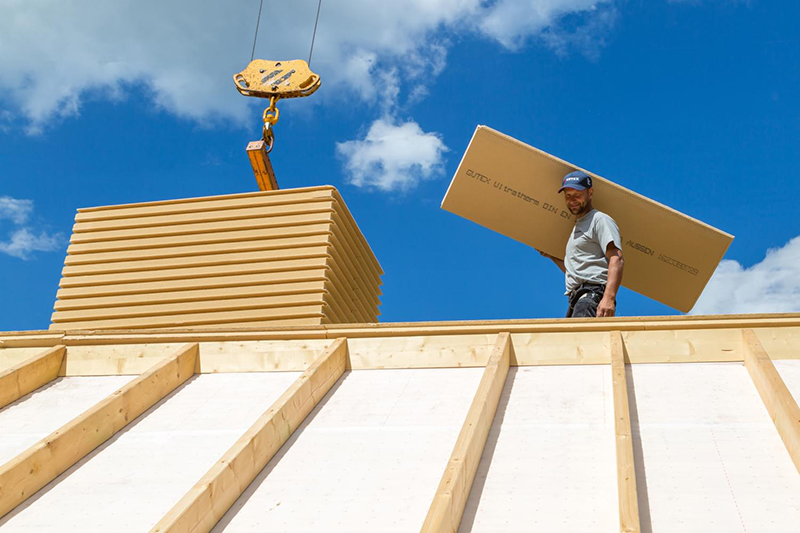
Andy Cook, technical specification advisor at Ecological Building Systems, explains why natural insulation is the perfect complement to timber frame construction
TIMBER frame has, for many decades, been the most common type of construction in Scotland – with around 83% of new homes built using this method. Its benefits in terms of energy efficiency, sustainability and thermal performance are widely recognised and, with many homes being built to Passivhaus standards, these benefits become more important than ever.
When timber frame homes are combined with natural insulation materials, it further enhances their environmental credentials. It means the building can achieve significant reductions in both embodied carbon and energy usage, while providing a comfortable and healthy living environment.
What is natural insulation?
Natural insulation materials are sourced from renewable resources, such as wood fibres, hemp, sheep wool and jute. They have a significantly lower carbon footprint and a higher sequestered biogenic carbon content compared to conventional insulation options like foam or mineral wool. By making use of natural insulation, timber frame buildings can become an even more sustainable build.
Natural wood fibre insulation, such as Gutex Multitherm, a breathable insulated sarking board made from recycled wood chips, provide high levels of thermal insulation, significantly reducing heat loss during the winter and heat gain during the summer. The benefits of reduced energy consumption for heating and cooling, lower utility bills and a more comfortable living space are widely recognised.
Breathability
Natural insulation materials within a timber frame construction not only contribute to energy efficiency and sustainability, but also help to prevent condensation issues inside the building. This is because one of the main characteristics of natural insulation materials is their breathability (low moisture vapour diffusion resistance) and high moisture sorption/desorption properties.
Unlike synthetic insulation, which can trap moisture and lead to condensation issues, natural insulation allows for the passage of water vapour through the walls. This prevents the build-up of moisture within the building envelope, reducing the risk of interstitial condensation, mould, rot and other moisture-related problems. It also contributes towards maintaining a healthy indoor air quality by allowing moisture from everyday activities such as cooking and bathing to escape from the building.
Over the past few years, there has been a rise in demand for wood fibre insulation, due to specifiers recognising its technical advantages and environmental characteristics compared to synthetic materials. Wood fibre insulation has been found to be effective in preventing overheating as it absorbs excess heat and prevents temperature spikes within the building. During cooler weather, wood fibre insulation also gradually releases stored heat and helps maintain a comfortable indoor environment.
Established over 80 years ago, Gutex was one of the first innovators of a dry wood fibre board manufacturing process for insulation. Gutex has secured EPDs (Environmental Product Declarations) for its complete product range and is natureplus certified, which further demonstrates its environmental and healthy living credentials.
Natural insulation options
The following are popular choices for natural insulation:
Wood fibre boards: High-quality wood fibre insulation boards are made from timber obtained from sustainably managed forests. The chips and shavings originate from untreated spruce and are a by-product of the trees being used in other ways.
Gutex wood fibre boards offer excellent thermal and acoustic insulation properties, reducing both heat loss and sound transmission. In addition, they are vapour-permeable, allowing the timber frame structure to breathe and preventing moisture accumulation. The boards are also windtight and protect the insulation behind the boards in between timber from wind washing (reduces thermal by-pass). By wrapping Gutex Wood fibre insulation boards around the external wall and roof timbers then thermal bridging is also significantly reduced.
Thermo Hemp Combi Jute: Thermo Hemp Combi Jute is an innovative insulation product made from a combination of hemp and upcycled jute fibres. This natural insulation material provides excellent thermal performance and sound absorption properties. With careful design as a breathable material, it ensures moisture management within the timber frame construction.
Gutex Thermoflex: Gutex Thermoflex is a high performance easy-to-install flexible wood fibre insulation made from recycled wood chips. Thermoflex is supplied in 1,350mm long mats (batts) and provides a high level of thermal insulation in winter and helps to significantly reduce the risk of overheating in summer. Gutex Thermoflex can easily be friction fitted in between timbers The product is also highly breathable so can assist in regulating humidity and controlling moisture in the building all year round.
Blown-in fibre insulation: Gutex Thermofibre is a loose fill fibrous insulation material, which contains a high level of sequestered biogenic carbon that can be blown-in to enclosed spaces in timber frame wall, roof, floor and ceiling structures. It is ideal for use in lofts as a loose covering of wood fibre blown over the ceiling joists. It is also very beneficial when insulating I beams, posi-joists and twin stud systems, where the installation of insulation quilts or batts would be difficult to achieve a full-fill. Fibrous insulation like Thermofibre can achieve excellent continuous insulation with no air gaps between the insulation, timbers or metal frame elements. Services like pipes and cables and awkward shapes can also be fully insulated with no gaps.
Passivhaus construction
For Passivhaus projects, natural insulation materials are an effective choice, helping buildings to achieve a high level of energy efficiency while maintaining a healthy indoor environment. Many Passivhaus constructions use natural wood fibre boards and airtight racking systems to ensure optimal thermal performance, combined with moisture management within a timber frame construction.
Installation
Correct installation of natural insulation, like all insulation materials, is vitally important. This includes ensuring airtightness by sealing joints, using appropriate tapes and sealants and integrating insulation seamlessly into the building envelope. It is also important to consider the compatibility of different materials and their interaction with moisture to prevent any potential issues in the future.
A sustainable, energy efficient, natural solution
Timber frame construction combined with natural insulation materials offers a sustainable, energy-efficient and comfortable solution for building environmentally friendly homes. The use of natural wood fibre boards and flexible insulation provides excellent thermal performance, breathability and moisture management within the timber frame structure.
By harnessing the inherent properties of natural insulation, timber frame buildings can be created that not only reduce energy usage but also that contribute to a greener and healthier future.







